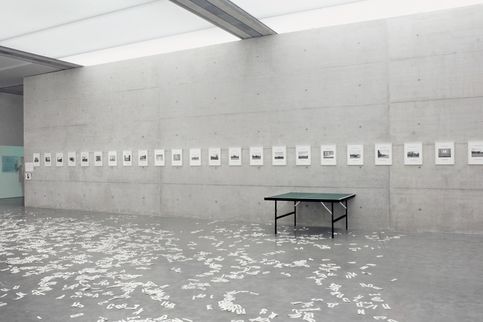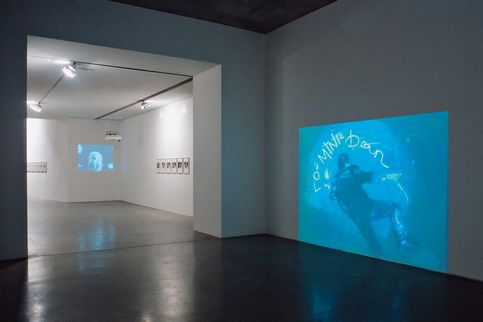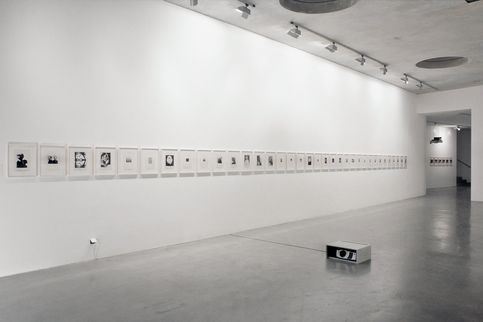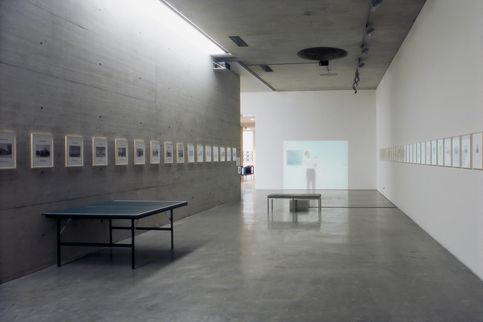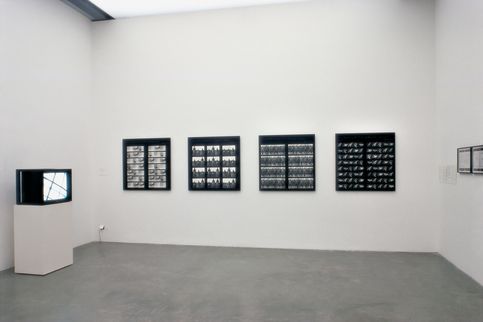COLLECTED VIEWS
FROM EAST OR WEST
Curator: Sabine Breitwieser
Curatorial Assistant, Exhibition production: Hemma Schmutz
Works by Marina Abramovic, Pavel Braila, Harun Farocki, Stano Filko, Andrea Fraser, Gorgona, Tomislav Gotovac, Dan Graham, Hans Hollein, Sanja Ivekovic, Milan Knizak, Julius Koller, Jaroslaw Kozlowski, Edward Krasinski, Andreja Kuluncic, Dalibor Martinis, Dora Maurer, Ewa Partum, Adrian Piper, Marjetica Potrc, Jozef Robakowski, Goran Trbuljak, Andrei Ujica and others.
The intention of this exhibition was, as part of a larger project, to reflect and, above all, to intensify the Generali Foundation’s commitment to art from Central and Eastern Europe (the CEE region). In contrast to the usual polarization of West and East, the emphasis was put on interaction and parallel developments. COLLECTED VIEWS FROM EAST OR WEST marked the beginning of a cycle of exhibitions on various themes addressed in the collection which were accompanied by a series of theoretical publications.
Sharpened by post-colonial discourses, our ideas about the relationship of the West to the East -and vice versa -have changed dramatically. In exhibitions such as "translocation (new) media art (1999)", "Re-Play (2000)" "double life (2001)" "Designs for the Real World (2002)", the Generali Foundation had already explored some important aspects. For some years, artists from the CEE region were featured in the program as a matter of course - both in exhibitions and the collection. The exhibition, COLLECTED VIEWS FROM EAST OR WEST, again raised the question of difference and interaction that determines the parallel developments in the different artistic movements. In keeping with the Generali Foundation’s major focus, emphasis was placed on the art of the 1960s and 1970s, happenings and actions, performance and conceptual art, as well as film, video and photography. Significant works by artists from former Eastern bloc countries entered into a dialogue with some of the at this time most recent acquisitions of the Generali Foundation collection.
The fact that artists from the countries east of the so-called Iron Curtain did indeed participate in international art movements usually ascribed solely to the West is documented by catalogues of important international exhibitions of the time. There was an exchange of information and the opportunity to travel and take part in exhibitions such as the Biennale de Paris/France (1969 and 1971), Prospect 71 in Düsseldorf/Germany, Trigon in Graz/Austria (from 1963) or Works and Words (1979) in Amsterdam/Holland. Especially in the former Yugoslavia, in return, international artists were invited to exhibit their work there as well.
Fluxus and happenings, as well as actions in public spaces, started in Central and Eastern Europe as far back as the early 1960s and were represented in the exhibition by artists such as Stano Filko, Milan Knizak, Julius Koller, Jaroslaw Kozlowski, and Ewa Partum. In 1965 Stano Filko, Zita Kostrova, and Alex Mlynareik declared the city of Bratislava to be an art work for the period of seven days. The accompanying manifesto, entitled Happsoc, combined the concept of the happening with that of society. Since 1970 Julius Koller photographed himself each year as U.F.O.-naut J.K. (U.F.O). In these portraits the artist presents himself as a cultural individual acting at an extra-terrestrial and fictitious distance from everyday life under communism and post-socialism.
Utopian architecture, in Vienna renowned from the work by Hans Hollein and Walter Pichler, can also be found in Slovakia. There, in the second half of the 1960s, Stano Filko, also constructed large pneumatic sculptures which were exhibited internationally. Since the 1990s Slovenian architect and artist Marjetica Potrè, who was already featured in the Generali Foundation collection, has dedicated her work to the innovative spirit of individual initiatives, thus again reconsidering the relationship between architecture, design and society.
Conceptualism in the visual arts was already a common practice during the early 1960s, especially around the group Gorgona in Zagreb. The journal Gorgona functioned as a display for presentations which very early on showed the basic structures of conceptual art, such as seriality and self-referentiality. The strong linguistic tradition of Eastern Europe and approaches to formal logic are to be found in the work of the Polish artist Jaroslaw Kozlowski. From 1972 to 1974 he presented his three-part exhibition project Metaphysics (1972), Physics (1973) and Ics (1974) in the Foksal Gallery in Warsaw. In this series of installations he raised fundamental questions about the relationship between the signified and the signifier, space and time, language, subject and object. Relocated Planes (1969) by US artist Adrian Piper, restored and installed for the first time, functioned as an important point of reference in this section of the exhibition. A selection from a large group of very early drawings by Dan Graham, also from the collection, was included here in addition.
In addition to actions and happenings, some artists in Eastern Europe were also able to present installations in public spaces at a very early stage. Beside the documentation of the project Zone of the Imagination (1970) by Jaroslaw Kozlowski, which he presented in the public space in Osieki, among other locations, the exhibition included two works by Polish artist Ewa Partum. In Legality of Space (1970), an installation in Freedom Square in Lodz, Partum combined existing traffic signs with others created by herself, thus deconstructing the appellative and normative character of signs and language. The tradition of intervention through art projects in public spaces was continued in the 1990s by the poster action Nama (2000) by Andreja Kuluncic. It thematized the closing of a popular supermarket chain that had been unable to withstand the conditions imposed by the new market economy in Croatia.
The exhibition audiovisual messages - (Trigon ’73) in Graz/Austria resulted in an intensive exchange between international artists and artists from former Yugoslavia in the field of the new media. During this first European manifestation of video art, artists such as Sanja Ivekovic, Dalibor Martinis, and Goran Trbuljak from Croatia were able to create videos for the first time. In his video No. 2 (1973) Trbuljak critically examines the possibilities of exchange and of understanding beyond all language barriers.
Performance art of the 1970s, which somehow emerged from happening and action art, was represented in the exhibition by the outstanding work of Marina Abramovic. In her early performances Abramovic explored the limits of what is physically bearable, both for the artist and the audience. Her work is also characterized by a distinct feminist perspective. Art Must Hang (2001), Andrea Fraser’s "reconstruction" of an opening speech by German artist Martin Kippenberger in the "Club an der Grenze" (Club at the Border) in Burgenland (south-east Austria) is located within this tradition.
Explicit political content could be found in some of the exhibited works. In I Am Adressing You Man to Man created for the election year of 2003 - Dalibor Martinis examines Croatia’s path to democracy in 100 stations. The intersection of public and private and the transformation this brings are documented in a video by Josef Robakowski. In From my Window (1978-1999) the artist filmed the same city square over several years, including the parades of May 1. And, in Videograms of a Revolution (1992), Harun Farocki and Andrei Ujica have documented events during the revolution in Romania from the TV set.
Over the last few years, the Generali Foundation has devoted itself intensively to researching certain specific topics as well as deepening the scope of the collection. The collection catalogue, published in 2003, and the international exhibition tour of the collection launched in spring 2005 were the result of these efforts.

